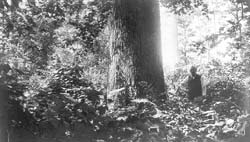
...And on the other side valleys spreading half a league before reaching the hills, which have no trees but walnut and oaks; and behind these, prairies like those I have just spoken of ...[along the river] you find...walnuts, ash, whitewood, Norway maple, cottonwood, a few maples, and grass, taller in places than a man....marshes, which in autumn and spring are full of bustards, swans, ducks, cranes, and teals,....[and] hills covered with wood,...from the edge of which are seen prairies of extraordinary extent.Settlers frequently commented on the size of the trees in the undisturbed forests they found, usually along rivers. Photographs taken near the Wabash River in the late 1800s show the huge trees described in so many of the pioneers' journals as being of "prodigious height and girth."
The early settlers not only recorded the presence of various plant communities, but also often discussed fire, its frequency, and its effect on the communities. These notes add to our understanding of the pre-European landscape in Illinois.
 |
| Elm
with 18' ground circumference.
Near Olney, Illinois Ridgway photograph collection, Illinois State museum collection (click on image to enlarge) |
|
|
Copyright © 2000 Illinois State Museum